AdaBoost - Bước đi đầu của Boosting
Bài đăng này đã không được cập nhật trong 4 năm
I. Giới thiệu về AdaBoost
Các model Machine learning (không sử dụng Neural Network) có thể khái quát như sau:
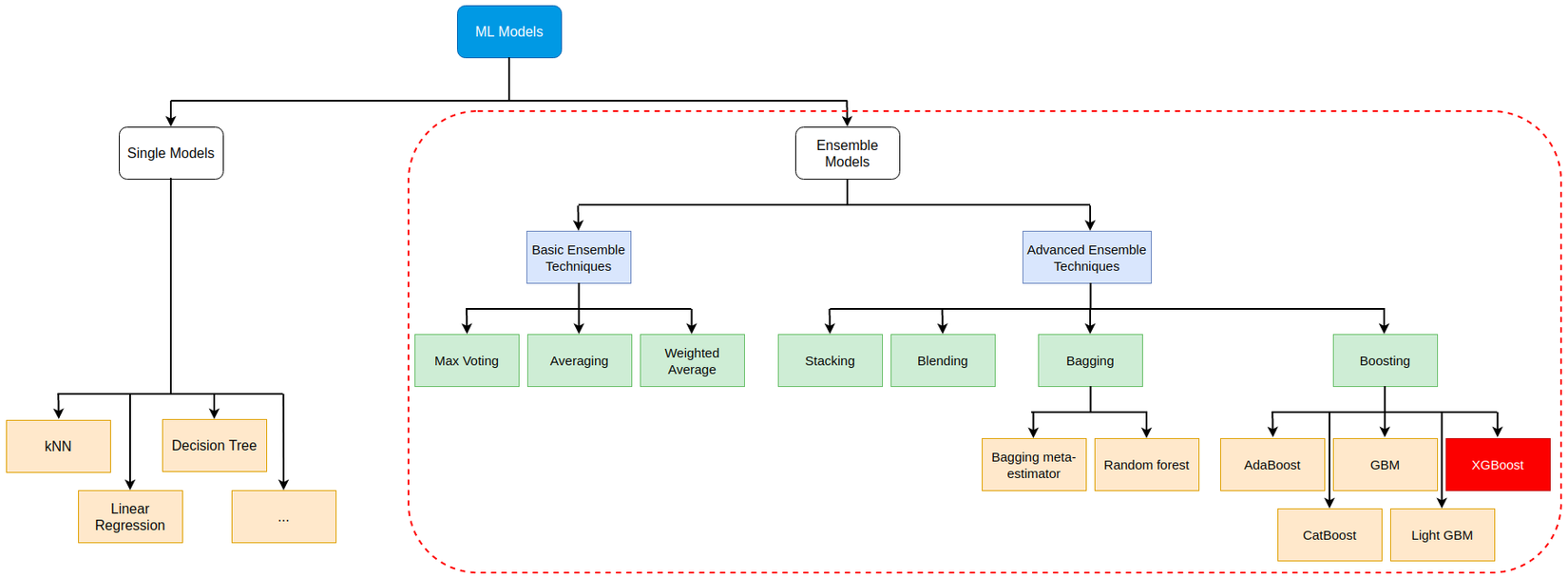
Để hiểu rõ hơn các bạn có thể tham khảo 2 bài viết Gradient Boosting - Tất tần tật về thuật toán mạnh mẽ nhất trong Machine Learning và Ensemble learning và các biến thể (P1)
Trong bài viết này, mình giới thiệu 1 thuật toán, có thể coi là tổ tiên khai sinh ra Gradient Boosting hiện tại - AdaBoost (Hiện giờ AdaBoost được coi là 1 trường hợp đặc biệt của Gradient Boosting)
AdaBoost, tên đầy đủ là Adaptive Boosting, là thuật toán thuộc nhánh Boosting trong Ensemble learning. Với ý tưởng đơn giản là sử dụng các cây quyết định (1 gốc, 2 lá) để đánh trọng số cho các điểm dữ liệu, từ đó tối thiểu hóa trọng số các điểm bị phân loại sai (trọng số lớn), để tăng hiệu suất của mô hình
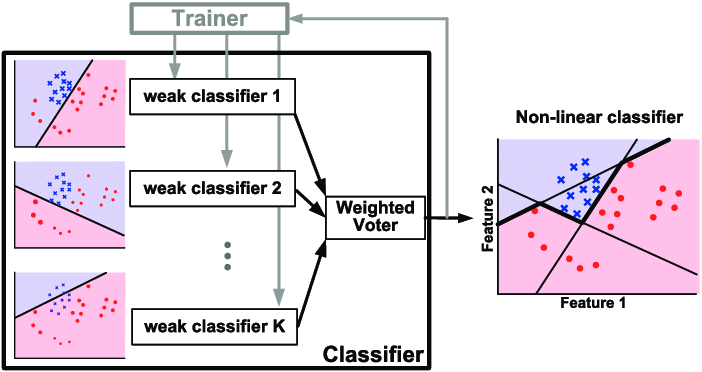
II. Giải thuật AdaBoost
AdaBoost có thể hình dung đơn giản qua flowchart:
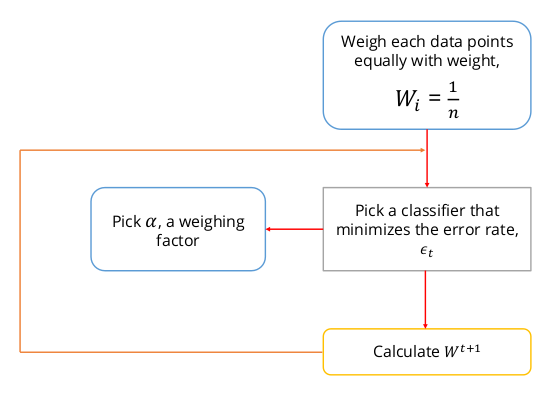
Có nghĩa là, với:
- Tập dữ liệu , với
- Trọng số các điểm dữ liệu tại weak leaner thứ t:
- weak-learners
- Error function: , trong đó
- Output: , còn được gọi là strong leaner tại thời điểm t
Các bước triển khai cho thuật toán được mô tả như sau:
B1: Khởi tạo weights cho từng input:
B2: Với mỗi vòng lặp :
- Tìm weak-learners để tối thiểu hóa tổng error của các điểm bị phân loại sai,
- Tỉ lệ lỗi của weak leaners: , vì
- Gán trọng số cho weak-learners giá trị
- Cập nhật strong learner:
- Cập nhật lại weights:
- Chuẩn hóa lại weights: , có nghĩa là
B3: Ouput chính là dấu của biểu thức tổng các weak-learners nhân với trọng số của chúng, hay
Vậy, câu hỏi được đặt ra là
Tại sao gán trọng số cho weak-learners?
Việc đặt lại trọng số cho các weak-learners là vô cùng quan trọng, ở đây, thuật toán đã chỉ ra rằng khi , chúng ta có thể tối thiểu hóa hàm loss trong quá trình training.
Như thuật toán ở trên, sau vòng lặp thứ , strong leaner là tổ hợp tuyến tính của các weak leaners dưới dạng biểu thức:
Class của điểm chính là dấu của biểu thức . Tại vòng lặp , để tăng độ chính xác cho , ta cộng thêm weak-learners nhân với trọng số của nó:
Gọi là tổng exponential loss của trên từng điểm dữ liệu, ta có
Đặt trọng số = và với t > 1, ta được:
Nhận thấy có 2 khả năng xảy ra với mỗi điểm trong tập dữ liệu:
- Phân loại đúng:
- Phân loại sai: #
Khi đó:
Đến đây chỉ cần sử dụng kiến thức đạo hàm lớp 12 để tối thiểu hóa loss theo , như sau:
Min xảy ra khi , hay
Vì và không phụ thuộc vào i, nên:
Lấy Loga Nepe 2 vế,
Chuyển vế,
Áp dụng ,
Vì tỉ lệ lỗi của weak leaners và nên,
Trên đây là cách mà giá trị được tìm ra, cũng khá dễ để chứng minh. Lý thuyết về AdaBoost vậy đủ rồi, cùng mình đến với code nào (Lý thuyết cũng chỉ là lý thuyết  )
)
II. Implement model
2.1 Các thư viện cần dùng
import numpy as np
import matplotlib.pyplot as plt
import matplotlib as mpl
from typing import Optional
from sklearn.tree import DecisionTreeClassifier
from sklearn.ensemble import AdaBoostClassifier
from sklearn.metrics import confusion_matrix, accuracy_score, f1_score, recall_score
from sklearn.metrics import classification_report, log_loss
import warnings
warnings.filterwarnings('ignore')
2.2 Xây dựng model
Vì nhận 2 giá trị -1 và 1, nên mình cần có 1 hàm kiểm tra gíá trị của
def check(y):
assert set(y) == {-1,1}
return y
Bảng dưới đây giải thích các biến mình sử dụng trong code mà ý nghĩa của chúng:
| Tên biến | Chiều | Kí hiệu trong giải thuật | Ý nghĩa |
|---|---|---|---|
| sample_weights | (T,n) | w | Ma trận trọng số các điểm trên các weak-learners |
| current_sew | (n,) | Trọng số các điểm tại weak-learners thứ t | |
| new_sew | (n,) | Trọng số các điểm tại weak-learners thứ t+1 | |
| stumps | (T,) | h | Danh sách các weak-learners) |
| stump | (1,) | Weak-learners thứ t | |
| stump_weights | (T,) | A | Trọng số các weak-learners |
| stump_weight | (1,) | Trọng số weak-learners thứ t | |
| errors | (T,) | E | Danh sách tỉ lệ lỗi của các weak-learners |
| error | (1,) | Tỉ lệ lỗi của weak-learners thứ t | |
| predict(X) | (n,) | Ouput thuật toán |
Tiếp theo là xây dựng mô hình
Khởi tạo các biến
def init_model(iters, X):
n = X.shape[0]
sample_weights = np.zeros((iters, n))
stumps = np.zeros(iters, dtype= object)
stump_weights = np.zeros(iters)
errors = np.zeros(iters)
return stumps, stump_weights, sample_weights, errors
Triển khai mô hình
Tóm tắt lại thuật toán:
Tại mỗi vòng lặp, chọn weak-learners , tối thiểu hóa tổng trọng số các điểm bị phân loại sai , sau đấy tính tỉ lệ lỗi , dùng để tính trọng số cho weak-learners thứ t , cuối cùng dùng kết quả vừa tính được để cải thiện output
Vì mục tiêu bài này là hiểu AdaBoost, nên weak-learners mình sử dụng luôn DecisionTreeClassifier được xây dựng trong sklearn.ensemble với trọng số (max_depth=1, max_leaf_nodes=2)
def AdaBoostClf(X, y, iters= 10):
n = X.shape[0]
# Check y
y = check(y)
# Initialize
stumps, stump_weights, sample_weights, errors = init_model(iters= iters, X= X)
# First weight = 1/n
sample_weights[0] = np.ones(shape= n) / n
for i in range(iters):
# Fit for stump: weak learner
current_sew = sample_weights[i]
stump = DecisionTreeClassifier(max_depth= 1, max_leaf_nodes= 2)
stump = stump.fit(X, y, sample_weight= current_sew)
# Calculate error
stump_pred = stump.predict(X)
error = current_sew[stump_pred != y].sum()
stump_weight = np.log((1 - error) / error) / 2
# New sample weight
new_sew = current_sew * np.exp(-1 * stump_weight * y * stump_pred)
# Renormalize weights
new_sew = new_sew / new_sew.sum()
# If not last iter, update sample weights for i+1
if (i + 1) < iters:
sample_weights[i+1] = new_sew
# Save result
errors[i] = error
stumps[i] = stump
stump_weights[i] = stump_weight
return stumps, stump_weights, sample_weights
2.3 Predictions
Như đã đề cập ở trên, kết quả phân loại từng điểm chính là dấu của biểu thức
với (+) nghĩa là và (-) là
def predict(X, stumps, stump_weights):
stump_preds = np.array([stump.predict(X) for stump in stumps])
return np.sign(np.dot(stump_weights, stump_preds))
III Testing
3.1 Fake datasets
Tạo dữ liệu
Mình sử dụng bộ dữ liệu đã đơn giản hóa từ sklearn documentation
def make_dataset(n: int = 100, random_seed: int = None):
n_per_class = int(n/2)
if random_seed:
np.random.seed(random_seed)
X, y = make_gaussian_quantiles(n_samples=n, n_features=2, n_classes=2)
return X, y*2-1
X, y = make_dataset(n=30, random_seed=10)
Dữ liệu đã có rồi, tiếp theo mình xây dựng một hàm để biểu diễn các điểm và decision boundary của chúng
def plot_adaboost(X: np.ndarray,
y: np.ndarray,
stumps= None, stump_weights= None, roll = 0,
clf= None,
sample_weights: Optional[np.ndarray] = None,
ax: Optional[mpl.axes.Axes] = None):
y = check(y) # Kì vọng nhãn bằng ±1
if not ax:
fig, ax = plt.subplots(figsize=(5, 5), dpi=100)
fig.set_facecolor('white')
pad = 1
x_min, x_max = X[:, 0].min() - pad, X[:, 0].max() + pad
y_min, y_max = X[:, 1].min() - pad, X[:, 1].max() + pad
if sample_weights is not None:
sizes = np.array(sample_weights) * X.shape[0] * 100
else:
sizes = np.ones(shape=X.shape[0]) * 100
X_pos = X[y == 1]
sizes_pos = sizes[y == 1]
ax.scatter(*X_pos.T, s=sizes_pos, marker='+', color='red')
X_neg = X[y == -1]
sizes_neg = sizes[y == -1]
ax.scatter(*X_neg.T, s=sizes_neg, marker='.', c='blue')
if clf:
plot_step = 0.01
xx, yy = np.meshgrid(np.arange(x_min, x_max, plot_step),
np.arange(y_min, y_max, plot_step))
Z = clf.predict(np.c_[xx.ravel(), yy.ravel()])
Z = Z.reshape(xx.shape)
# If all predictions are positive class, adjust color map acordingly
if list(np.unique(Z)) == [1]:
fill_colors = ['r']
else:
fill_colors = ['b', 'r']
ax.contourf(xx, yy, Z, colors=fill_colors, alpha=0.2)
if roll:
plot_step = 0.01
xx, yy = np.meshgrid(np.arange(x_min, x_max, plot_step),
np.arange(y_min, y_max, plot_step))
Z = predict(np.c_[xx.ravel(), yy.ravel()], stumps, stump_weights)
Z = Z.reshape(xx.shape)
# If all predictions are positive class, adjust color map acordingly
if list(np.unique(Z)) == [1]:
fill_colors = ['r']
else:
fill_colors = ['b', 'r']
ax.contourf(xx, yy, Z, colors=fill_colors, alpha=0.2)
ax.set_xlim(x_min+0.5, x_max-0.5)
ax.set_ylim(y_min+0.5, y_max-0.5)
ax.set_xlabel('$x_1$')
ax.set_ylabel('$x_2$')
plot_adaboost(X, y)
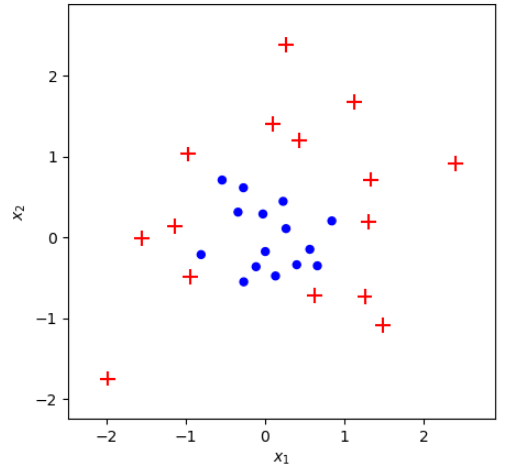
Performance
Mình sẽ so sánh thử khi train bộ dữ liệu này bằng sklearn.ensemble.AdaBoostClassifier và code tự implement ở trên xem thế nào
clf = AdaBoostClassifier(n_estimators=15, algorithm='SAMME').fit(X, y)
plot_adaboost(X, y, clf=clf)
train_err = (clf.predict(X) != y).mean()
print(f'Train error: {train_err:.1%}')
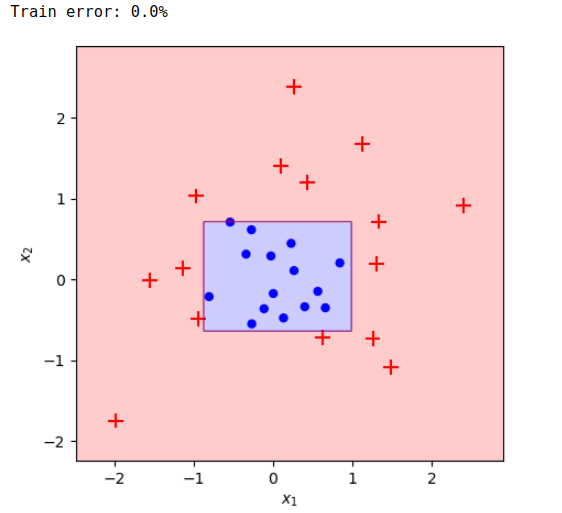
Đơn giản ghê, vậy với code implement thì sao?
# Train with datasets
stumps, stump_weights, sample_weights = AdaBoostClf(X, y, iters= 15)
pred = predict(X, stumps, stump_weights)
# Show metrics
print("Accuracy score: %f" % accuracy_score(y, pred))
print("Confusion Matrix:")
print(confusion_matrix(y, pred))
print(classification_report(y, pred))
print('Log loss:', log_loss(y, pred)/len(y))
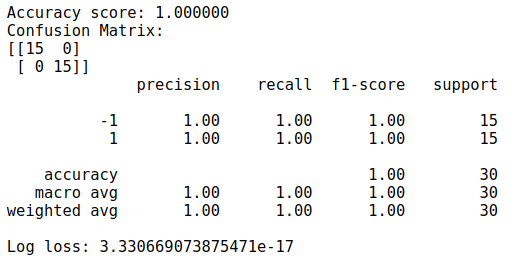
plot_adaboost(X, y, stumps, stump_weights, roll= 1)

Vì bộ dữ liệu khá đơn giản nên kết quả cũng không nằm ngoài dự tính 
Visualize kết quả qua từng vòng lặp
Ở trên mình đã lưu toàn bộ kết quả của từng vòng lặp nên bây giờ có thể dùng kết quả đó để visualize cách mà Adaboost hoạt động qua từng vòng lặp đó:
- Độ lớn các điểm trên hình thể hiện trọng số của các điểm, điểm bị phân loại sai trọng số sẽ càng lớn, và ngược lại
- Hình bên trái là weak-learners thứ t
- Hình bên phải thể hiện cho output của AdaBoost sau t weak-learners
def truncate_adaboost(stumps, stump_weights, t: int):
assert t > 0, 't must be a positive integer'
x = stumps[:t]
y = stump_weights[:t]
return x, y
def plot_staged_adaboost(X, y, stumps, sample_weights, stump_weights, start=0, end=10):
# larger grid
fig, axes = plt.subplots(figsize=(8, (end-start)*3),
nrows=(end-start),
ncols=2,
sharex=True,
dpi=100)
fig.set_facecolor('white')
for i in range(start, end):
ax1, ax2 = axes[i-start]
# Plot weak learner
ehe = ax1.set_title(f'Weak learner at t={i + 1}')
plot_adaboost(X, y, clf= stumps[i],
sample_weights= sample_weights[i],
annotate=False, ax=ax1)
# Plot strong learner
new_stumps, new_sw = truncate_adaboost(stumps, stump_weights, t=i + 1)
ehe = ax2.set_title(f'Strong learner at t={i + 1}')
plot_adaboost(X, y, new_stumps, new_sw, sample_weights= sample_weights[i], roll=1, annotate=False, ax=ax2)
plt.tight_layout()
plt.subplots_adjust(top=0.95)
plt.show()
Ở dây mình visualize từ cây thứ 10
plot_staged_adaboost(X, y, stumps, sample_weights, stump_weights, start=9, end=15)


Có thể thấy, tại một số thời điểm (vd: t=11, 13, 15), các điểm được phân loại toàn bộ vào (+), tại sao vậy? Đơn giản là vì với tổng trọng số mẫu hiện tại, cách tốt nhất để tối thiểu hóa trọng số là phân loại tất cả các điểm là (+). Có nghĩa là, vì các mẫu (-) được bao quanh bởi các mẫu (+) có trọng số lớn, nên với 1 cây Decision Tree đơn giản, không thể classify tập dữ liệu bằng 1 đường thẳng phân tách mà làm không làm tăng trọng lượng trong số các diểm (+) bị phân loại sai, điều đó thật tệ với thuật toán, vì khi phân loại tất cả các điểm thành (+), các điểm (-) bị phân loại sai làm tăng trọng số các điểm (-), hay tăng tổng trọng số các điểm lên. Tuy nhiên, điều đó không đủ để ngăn thuật toán hội tụ, với việc cây thứ t phân loại sai làm tăng trọng số các mẫu (-), sẽ giúp cho cây t+1, tìm được 1 đường phân tách mang tính tích cực và quyết định hơn cho thuật toán
3.2 Bộ dữ liệu Titanic
Sau khi đã đại khái biết được sức mạnh của AdaBoost với bộ dữ liệu fake kia rồi, mình muốn chạy thử với bộ dữ liệu thực tế hơn chút xem sao, và lựa chọn của mình là Titanic
Sơ qua về bộ dữ liệu Titanic, là mình phải phân loại xem hành khách là sống(1) hay chết(0) (Feature: Survived) từ những features còn lại. Titanic thì quá là nổi tiếng luôn rồi 
Download datasets và tiền xử lý dữ liệu
Mình sẽ xử lý qua chút để dữ liệu clear với mô hình hơn
# Download datasets
titanic = pd.read_csv('https://raw.githubusercontent.com/dhminh1024/practice_datasets/master/titanic.csv')
# Data manipulation
titanic.fillna(titanic['Age'].mean(), inplace=True)
titanic.replace({'Sex':{'male':0, 'female':1}}, inplace=True)
titanic['FamilySize'] = titanic['SibSp'] + titanic['Parch'] + 1
titanic.drop(columns=['PassengerId', 'Name', 'SibSp', 'Parch', 'Ticket', 'Fare', 'Cabin', 'Embarked'], inplace=True)
titanic.head()
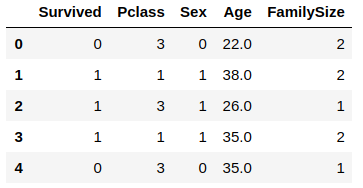
Vì giá trị output y là {+1, -1} nên mình đã đổi toàn bộ giá trị 0 thành giá trị -1. Tiếp theo mình chia bộ dữ liệu ra làm 2 phần train và val
from sklearn.model_selection import train_test_split
X = titanic[['Pclass', 'Sex', 'Age', 'FamilySize']].values
y = titanic[['Survived']].values
y[y == 0] = -1 # y must be {+1, -1}
X_train, X_val, y_train, y_val = train_test_split(X, y, test_size=0.2, random_state=102)
print('Training set:', X_train.shape, y_train.shape)
print('Val set:', X_val.shape, y_val.shape)
Sau khi đã có 2 tập dữ liệu, bước tiếp theo là fit với mô hình
# Training
stumps1, stump_weights1, sample_weights1 = AdaBoostClf(X= X_train, y= y_train.reshape(-1), iters= 10)
predt = predict(X_val, stumps1, stump_weights1)
Và đây là kết quả
# Show metrics
print("Accuracy score: %f" % accuracy_score(y_val, predt))
print("Confusion Matrix:")
print(confusion_matrix(y_val, predt))
print(classification_report(y_val, predt))
print('Log loss:', log_loss(y_val, predt)/len(y_val))
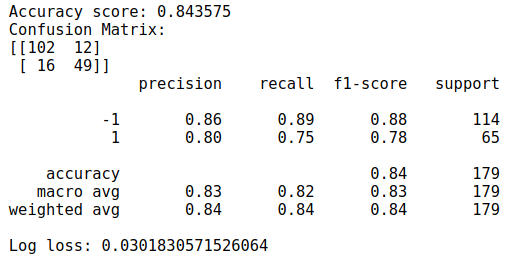
Cũng không tệ, AdaBoost dù không phải top trong Ensemble, nhưng dù sao vẫn là 1 thuật toán vô cùng mạnh mẽ
IV. Lời kết
Vậy là mình đã giới thiệu đến các bạn thuật toán AdaBoost, nếu có thắc mắc, góp ý, hoặc muốn biết thêm về thuật nào khác, hãy comment để mình biết nhé. Cảm ơn các bạn đã dành thời gian đọc bài viết của mình. See ya!! (KxSS)
Tham khảo
All rights reserved
